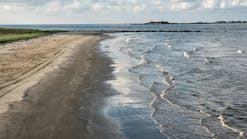Chicago Water District Opens Locks, Sends Sewage into Lake Michigan
Source Chicago Tribune
Heavy rains this week flushed storm water and sewage from the Chicago River into Lake Michigan for the first time in five years. Still, Chicago and other coastal cities have not detected any changes in the quality of drinking water coming from the lake.
The Metropolitan Water Reclamation District opened locks and gates, releasing the runoff and sewage into Lake Michigan Thursday night, and city officials reported Friday that the bacteria levels in untreated lake water had not changed. Some area park districts posted swimming advisories as a precaution but won't have their test results for another day.
From 6:55 p.m. Thursday to 6:00 a.m. Friday, at least 224 million gal of bacteria-laden water flowed from the North Shore Channel into Wilmette Harbor. "We'll increase our testing during the next few days, but the good news is we haven't seen anything unusual," said Gary Litherland of the Chicago Water Management Department. "That means we haven't needed to increase the amount of chlorine in our treatment process."
Lake Michigan's cool temperature, according to officials, will not allow most bacteria and viruses within the storm water to survive for long. Dilution also helps reduce potential health threats.
In the early 1900s, Chicago reversed the flow of the Chicago River to keep sewage out of the region's drinking water supply. For decades, though, the district has frequently allowed the river to flow back out into the lake following heavy bouts of rainfall. A subterranean labyrinth that can hold about 1.8 billion gal of water, roughly the effects of a 1-in. rain throughout the Chicago area, was installed in the mid-1970s. Two reservoirs that will allow for the capture and holding of about 18 billion gal are being built and scheduled to be complete in 2014.
"Little by little, we're nibbling away at this monster," said the district's general superintendent, Richard Lanyon.
Source: Chicago Tribune






